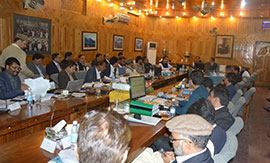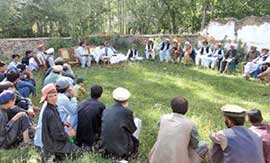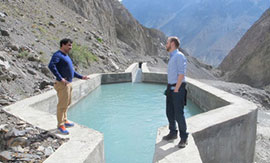
Economic Pillar
Given the multiplicity of factors influencing economic development, it is imperative to intervene in multiple areas and address economic and social issues simultaneously. Progress in economic development manifests itself through improvements in the quality of life. In the particular socio-economic setting of GBC, a sustained improvement in the inhabitants’ quality of life hinges upon inclusive economic growth and shared employment opportunities. AKRSP’s past efforts in developing economic infrastructure (e.g. roads, irrigation, and land development projects), promoting agricultural productivity and improving farming skills have been instrumental in this regard, for it increases farm surplus and income from the subsistence farming sector.
To further the agreed goals of employment and income generation AKRSP has more recently added enterprise development activities and tried a wide variety of approaches such as: promoting collective marketing of agriculture produce, providing intensive support to select micro-farming sectors, setting up AKRSP-owned lead enterprises. These initiatives have had varying degrees of success and impact.
In the review period, AKRSP’s economic pillar covered areas related to community infrastructure development, resource and institutional development, capacity building, natural resource management, livestock development, action research, and poverty targeting.
6.1 Community Infrastructure Development
The Community Physical Infrastructure Programme is one of the key components of AKRSP’s resource development strategy in GBC. It includes irrigation development projects, link roads, bridges, protective works, water supply schemes, and micro hydel plants. Initially, these projects were implemented under the institutional development program; however, it soon became clear that infrastructure investments also create sustainable sources for generating incomes and produce social benefits for communities by opening up new land, increasing the productivity of existing agriculture resources (including existing land) and increasing farmers’ access to markets for the supply of inputs and sale of surplus produce.
6.2 Resource Development
Since its inception in 1982, AKRSP has invested significant financial resources in its Resource Development Programme to create a local level resource base that improved the livelihood options and structures for the population of GBC, with a special focus on the poorest segments.
This program has several sub-components such as institutional development, human development, productive physical asset development and natural resources’ development and management (NRM). The single largest sub-component is infrastructure development, which is further divided into different small projects ranging from irrigation projects to link roads, bridges, protective works and hydel power stations. Similarly, the NRM component consists of agriculture, livestock, poultry, forestry, wildlife, and environment. These productive physical resources pay immediate and quick returns to beneficiaries.
6.2.1 Agriculture Development
Agriculture remains the mainstay of rural economy and the strategic focus of AKRSP’s investment and support is to develop this sector along modern patterns.
6.2.2 Livestock Development
6.2.3 Capacity Development
The capacity building component in the Resource Development Programme of AKRSP comprises formal training courses, workshops and conferences. Under this programme AKRSP trains both men and women in selected sub-sectors of agriculture, livestock management and environment. Increasingly, LSOs have developed their capacity to organize most of the training courses for their members in the traditional areas of plant protection management, tree nurseries, forestry development and management.
AKRSP continues to organize training courses in seed production, organic farming, fish farming, honey bee farming, vaccination, food and vegetable processing, guild management, livestock management and treatment in the livestock sector.
6.3 Market Development
There are several market-related challenges that hamper the development of potential enterprises and businesses and the expansion of potential markets to meet the demands for local goods and services. The importance of enterprises, businesses, service providers and institutions has increased manifold with the inception of EELY programme, which seeks to make youth a part in the economic mainstream by equipping them with the required skills through training. To understand the various market-related hurdles and issues, AKRSP has undertaken an extensive study- a Labour Market Assessment (LMA). Following the findings of this study and the lessons learnt from its previous programmes of marketing and enterprise development, AKRSP has developed a comprehensive strategy to support and promote market development.
The findings of the study and AKRSP’s experience show that the development of the private sector in this region is essential to ensure a broad-base growth and to sustain the development gains achieved. The demand for business development services in the programme area has been growing constantly; consequently, civil society- the public, private and the NGO sectors- should develop partnerships and linkages to meet this demand for services. AKRSP has been working with service providers to improve supply-side conditions and with the service recipients to improve the demand side conditions. To accelerate this process, AKRSP first identifies the demand for currently unavailable products and services and then searches for competitive service providers within the programme area and across Pakistan.
The Market Development Programme has different sub components that include:
- Institutional Development
- Capacity Building
- Poverty Targeting
- Action Research
To ensure a fair distribution of the benefits of these services and programmes, AKRSP purposely incorporates the needs, interests, and demands of women, with a particular focus on educated, young men and women.
6.3.1 Institutional Development
Through is Market Development Programme AKRSP supports entrepreneurs, producers, traders, and suppliers of the goods and services to form enterprises and business associations and networks. It also encourages them to manage their enterprises, businesses, production processes and surplus production. This strategy enables entrepreneurs and business representatives to derive the highest possible benefit from economies of scale through large, collective transactions of inputs and marketing of surplus production. Another very important part of the market development strategy is to create linkages, hold dialogues and lobby with the policymakers in the public and private sectors with other service providers to increase the bargaining position of entrepreneurs and create an enabling environment in which markets for products and services can function sustainably.
6.3.2 Capacity Building
Within the Market Development Programme, AKRSP mainly builds the capacity of individual men and women and business associations through the organization of formal training courses, workshops, conferences, exposure visits and exhibitions. This programme has three purposes:
- To develop an enterprise culture among communities and service providers working in different sectors in the area
- To increase the interaction between local business people and service providers
- To encourage community members- especially youth- to initiate their own businesses and enterprises
6.3.3 Action Research and Poverty Targeting
Owing to the growing complexity of the national and international economy, a thorough understanding of market dynamics is indispensable. It allows AKRSP to place the local economy in the national context and develop local plans accordingly. For that purpose, AKRSP carried out research on economic enterprise and developed business plans with local entrepreneurs.
Social Media
Recent News
Sadpara Development Project
April 9, 2018
Community mobilisation paying off in Chitral
June 21, 2016
Earthly matters: A bright future
June 21, 2016






